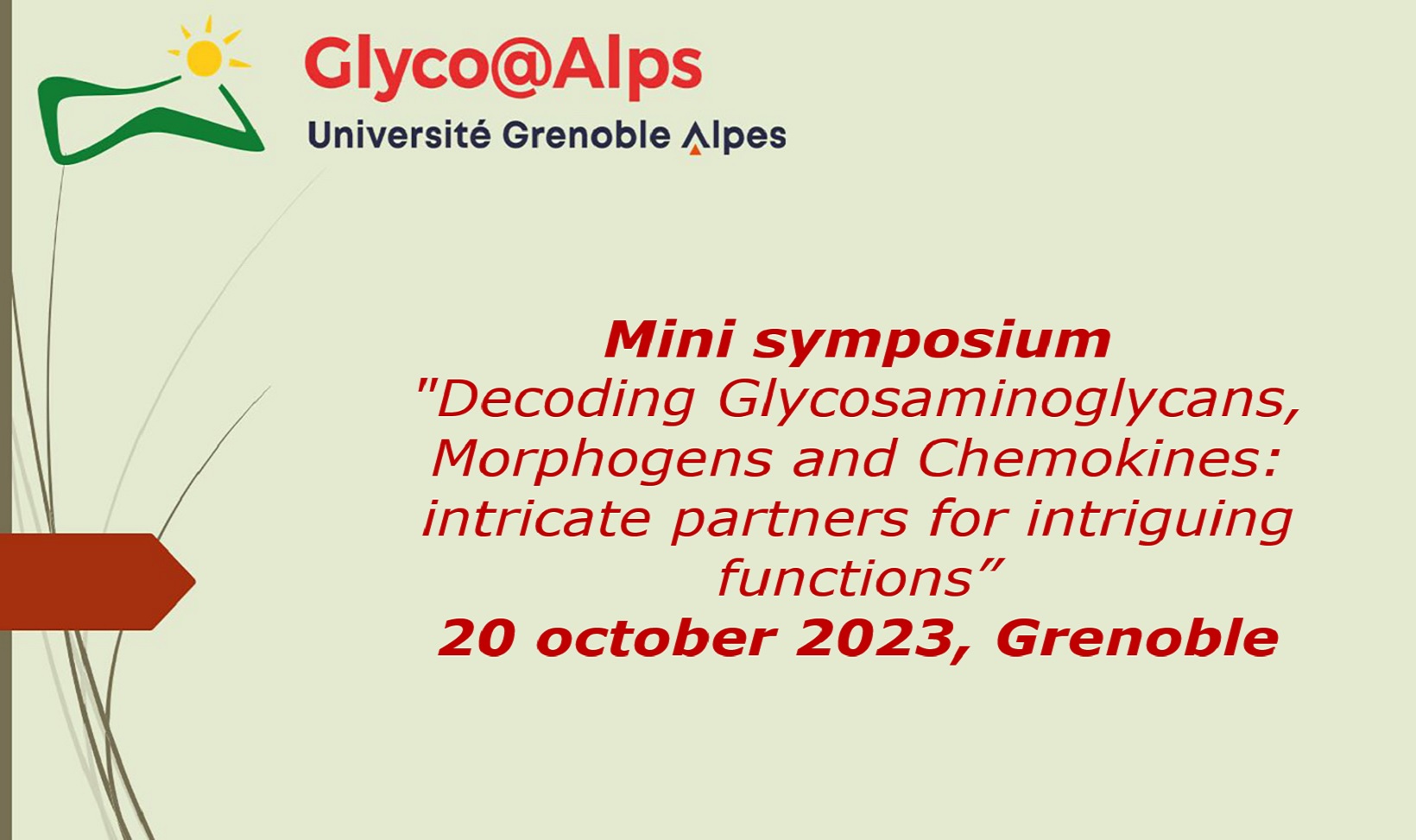- Share
- Share on Facebook
- Share on X
- Share on LinkedIn
Colloque
On October 20, 2023

Mini symposium : "Decoding Glycosaminoglycans, Morphogens and Chemokines: intricate partners for intriguing functions” is organized on the morning of 20th of october 2023.
PROGRAM:
9:30 – 10:00 Prof. Toril Holien, Norwegian University of Science and Technology (NTNU), Torgarden, Norway
Title: Modulating bone morphogenetic protein activity in multiple myeloma cells
Abstract: Bone morphogenetic proteins have an exceptional ability to induce growth arrest and apoptosis in multiple myeloma cells. The effect is dependent on the formation of an active signaling complex with the ligand and type I and type II receptors, and is mediated through the canonical SMAD pathway. The strength and duration of the signal correlates with cell death. We want to exploit this pathway to find better ways to target myeloma cells for apoptosis. The immunophilin FKBP12 is a natural intracellular antagonist of BMP-activity. We have found that targeting this protein with various drugs strongly potentiates BMP-induced apoptosis. We hope that our findings can lead to development of novel treatments for this incurable disease.
10:00 – 10:15 break
10:15 – 10:45 Dr. Douglas Dyer, University of Manchester, UK
Title: Extracellular matrix proteoglycan and chemokine collaboration in immune cell recruitment
Abstract: Chemokine mediated leukocyte recruitment is a key facet of the immune response, classically explained by interaction with receptors on leukocytes. Chemokines are central to inflammatory pathology but have yet to be targeted during inflammation. Therefore, we must revisit the field with fresh approaches to inform therapeutic development. Chemokine interactions with glycosaminoglycan (GAG) extracellular matrix components are important for their function, however, we do not understand why. CXCL4 mediates recruitment of a range of immune cells during diseases such as sepsis, atherosclerosis and cancer; however, there have been conflicting reports on its’ functional receptor. We hypothesise that CXCL4, and possibly other chemokines, function principally via interactions with the extracellular matrix components, glycosaminoglycans, instead of via classical chemokine receptors; a new understanding of the basic biology of chemokine function. Furthermore we propose that the extracellular matrix, specifically proteoglycans within the the cellular glycocalyx, play a much wider role in the immune cell recruitment and the immune response than is currently understood. Our lab is focused on uncovering novel pathways to inform development of future therapeutics to target the immune system.
10:45 – 11:15 Isabelle Compagnon, Institut Lumière Matière, Université Claude Bernard Lyon 1, France
Title: Integrating Molecular Physics tools and concepts to glycomics workflows
Abstract: In contrast with genomics and proteomics, the glycoanalytical toolbox still lacks routine, generic sequencing tools with the ability to characterize all types of carbohydrates. The challenges associated with carbohydrate structure analysis can be categorized as combinatorial and isomeric. The isomeric barrier corresponds specifically to the limitations of Mass Spectrometry (MS) in terms of resolution of isomeric structures: for instance, MS can be used to distinguish between a hexose and a deoxyhexose which has a different mass, but fails to distinguish between two hexoses. The combinatorial barrier corresponds to the exponentially increasing number of potential structures going from a monosaccharide to a disaccharides and so on. It affects several aspects of the analytical work: the production of exhaustive libraries of synthetic standards is virtually impossible, as well as the constitution of libraries of reference data. From these considerations, it appears that a carbohydrate sequencing method should have two essential properties: the capability to distinguish all types of isomers present in the carbohydrate class; and a “de novo” character, i.e. a sequence identification that does not require that the said sequence had been previously documented to serve as reference. In recent years, we proposed to apply Physical Chemistry tools developed in the community of gas phase molecular spectroscopy to tackle the challenges of Glycomics. We demonstrated the vibrational ion spectroscopy in the mid-Infrared range, which is implemented by injecting a tunable IR laser inside of the ion trap analyzer of a custom mass spectrometer, is a promising candidate for carbohydrate sequencing. Firstly, we demonstrated that the coupled MS-IR diagnostic can be used to resolve all types of isomers including anomers, epimers, regio- and stereo-isomers, ring size, ... Secondly, we established that the monosaccharide content and linkage of an oligosaccharide can be resolved iteratively using a minimal and accessible set of monosaccharides standards. Finally, we showcased the technical integration of the IR module in several MS- based glycomics workflows, including ESI and nanospray sources, ion mobility, liquid chromatography and tandem or multistage MS and screening. In addition to these proofs of concept, we will discuss the performances of MS-IR-based workflow for the analysis of two types of carbohydrates from natural sources: lichen polysaccharides and human serum glycoproteins.
Date
Localisation
Amphitheatre - Entry 1
CEA - Grenoble
- Share
- Share on Facebook
- Share on X
- Share on LinkedIn